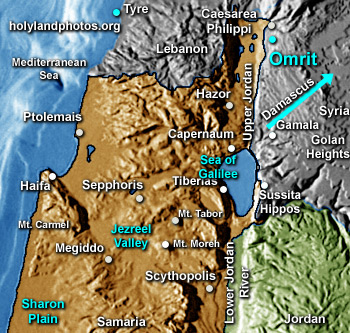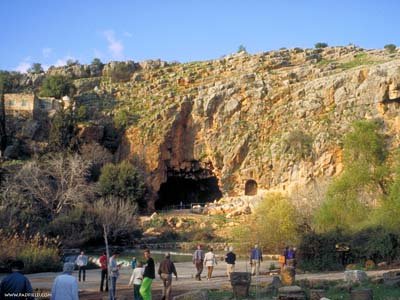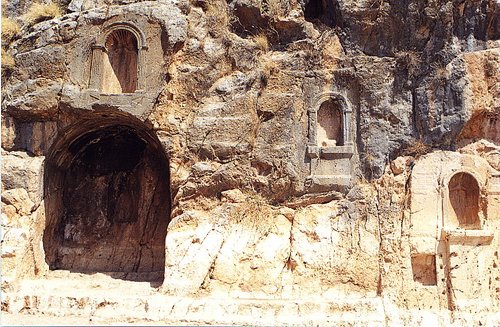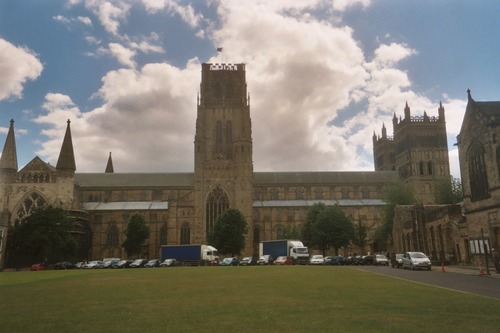
(courtesy HolyLand Photos/Maps)
One of the subjects not much discussed in Jesus studies is the forays Jesus made into foreign territories (Gerasa, Perea, Tyre, Herod Philippi’s realm). The stories about such visits to places outside the Holy Land are important as they show Jesus did not confine himself to the land of Israel. His visits to these other places seem to have been brief, but nevertheless, important.
One of the places Jesus likely passed on the way to Caesarea Philippi (see Mk. 8 and par.) is Omrit (the Arabic name of the spot). At Omrit there was indeed a temple of Augustus. Romans, probably from their base in Syria, had retrofited a Hellenistic shrine of some sort for their purposes., as they were apt to do. As Andy Overman pointed out in his SBL lecture there were three temples on this same location, and the dig there has unearthed how they were built one on top of the other in an enhancement and rennovation process. Like most Roman shrines (this one dates to from 20 B.C. to 30 A.D. so during the era of Jesus, the Romans were careful not to build such things on Jewish sacred soil, but we find them around the perimeters of the Holy Land, for example at Omrit and some of the cities of the Decapolis. Here are a few shots of Omrit—
(courtesy BiblePlaces.com)
Because this shrine is near the juncture of major roads going north south, and also east west, one can conclude that this might well have been a stopping place for Greco-Roman persons to offer a sacrifice, or pray, or even dine, perhaps including troops moving from Syria throughout the region. This temple at Omrit is just down the hill from the Greek village of Banyas, which was renovated by Herod Philipi as his capital or base of operations. This site of course is familiar to Gospel readers because of Mark 8 and parallels. Here are a few pictures of the more famous of these two sites.
What you are looking at is the famous cave of Pan, which some think was viewed as one of the entrances to Hades, and we also have here the niches from statues of various rulers and deities from the Greek and Roman sphere. Herod Philip was certainly interested in maintaining good relationships with Tiberius or any Emperor, which is one of the reasons for the renaming of the city after Caesar and himself.
One of the things that Overman rightly cautions against in his SBL lecture is the temptation to turn Jesus into some sort of anti-Roman revolutionary, which he was not. As Overman points out, Jesus in fact is not opposed to the paying of taxes to Rome, though he does not think his followers are obligated to pay the Tribute money. He opposes neither taxes to Rome nor the paying of the Temple tax. As Overman says, Rome is hardly on Jesus’ radar in his teachings, nor were any of the later NT writers overtly anti-Roman in their attitudes or writings. The evidence from Omrit and Banyas do not suggest the recent building of an Imperial cult temple in these locales. The temple at Omrit was from the earlier Augustan era.
The question remains as to why in the world Jesus would take his disciples to Caesarea Philippi within site of the famous cave and of those niches with statues, and up the hill from the Augustan temple? My suggestion is severalfold: 1) Jesus wanted to reveal his self-understanding and mission on his own terms, in his own good time, in his own way, and so he took the disciples to a place where there was no messianic speculation about him. Indeed, there was probably little conservative Jewish presence or speculation of any sort at all in this place. Herod Philip it will be remembered was only very partially Jewish in terms of his ethnic extraction. He was in fact like his father mainly Idumean (which is to say Edomite) and we all know how poorly Edomites and Hebrews got along; 2) Caesarea Philippi is on the way to the largest mountain in the area, Mount Hermon, and it may well be that Jesus stopped there on the way to Hermon, which may well be the site of the Transfiguration. Certainly Mark 9 follows hard on the heels of the account in Mark 8 of the visit to Caesarea Philippi; 3) Peter’s remarks at Caesarea are of course within the usual scope of Jewish speculation about messianic figures. One possible reason for having this ‘true confessions’ session at Caesarea Philippi would be to punctuate that Jesus was indeed a Jewish messianic figure quite unlike any pagan deity figures of any sort; 4) and if indeed the cave of Pan was seen as a portal to the Underworld, then the remark about “the Gates of Hades will not prevail against my community” become apt and probably authentic. Jesus is reassuring his disciples that his community will survive–living on; 5) this last suggestion makes even better sense if it is true that Jesus at the same locale for the first time told his disciples that the Son of Man must suffer many things, be killed and then rise again. In other words, though he was going to be killed, his community would not thereby die out. 6) the political cache of the Mark 8 story is that since Herod fancied himself a ruler, perhaps even a Jewish ruler in his father’s mold, Jesus would indirectly be critiquing such a claim by indicating he was the real Jewish anointed one.
Think on these things and tell me your reflections
BW3
![Omrit temple from east, tb032905151_thumb[1].jpg](https://wp-media.beliefnet.com/sites/137/import/assets_c/2009/12/Omrit%20temple%20from%20east,%20tb032905151_thumb%5B1%5D-thumb-404x270-9808.jpg)
![Omrit temple interior, tb032905141_thumb[1].jpg](https://wp-media.beliefnet.com/sites/137/import/assets_c/2009/12/Omrit%20temple%20interior,%20tb032905141_thumb%5B1%5D-thumb-404x270-9810.jpg)




